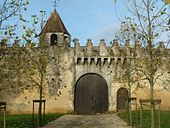Saint-Brice (Charente)
| Saint-Brice | ||
|---|---|---|

|
|
|
| region | Nouvelle-Aquitaine | |
| Department | Charente | |
| Arrondissement | cognac | |
| Canton | Cognac-1 | |
| Community association | Grand Cognac | |
| Coordinates | 45 ° 41 ′ N , 0 ° 17 ′ W | |
| height | 5-57 m | |
| surface | 9.30 km 2 | |
| Residents | 965 (January 1, 2017) | |
| Population density | 104 inhabitants / km 2 | |
| Post Code | 16100 | |
| INSEE code | 16304 | |
 Saint-Brice - Castle Park |
||
Saint-Brice is a southwestern French community with 965 inhabitants (at January 1, 2017) in the Charente in the region Nouvelle-Aquitaine .
location
Saint-Brice is about 20 meters above sea level. d. M. directly on the north bank of the Charente . Only about 5.5 kilometers (driving distance) in a north-westerly direction separate the place from the city of Cognac ; the lovely church of St-Martin de Gensac-la-Pallue is only about 7 kilometers to the south-east.
Population development
| year | 1968 | 1975 | 1982 | 1990 | 1999 | 2006 | 2016 |
| Residents | 778 | 950 | 963 | 1002 | 970 | 1061 | 966 |
At the first census in France in 1793, the place had 591 inhabitants; Only after the Second World War did a slow but steady population growth set in.
economy
Agriculture and especially viticulture have always played an important role in the Charente villages. While cereals were mainly grown for their own needs, one could earn good money with the export of wine to England and Scotland, whereby the winegrowers had to be content with the smaller part of the earnings. Today the north bank of the Charente near Saint-Brice belongs to the Petite Champagne of the large growing area of the cognac wines, while the south bank of the river belongs to the location of the Fins Bois .
history
Few data have come down to us about the history of Saint-Brice - in the suburb of La Garde-Épée , about 2.5 kilometers to the east, there are two dolmens from the time of the megalithic cultures ; In addition, remains of the foundations of a Roman building (thermal baths?) were discovered here. Perhaps not without reason, canons of the Augustinian order established the abbey or monastery of Châtre in this area in the 11th century . At that time, however, there was also the medieval town, whose houses were grouped around the church of Saint-Brice. In the 16th and 17th centuries, two feudal mansions ( châteaux ) were built, one in the village, the other near La Garde-Épée .
Attractions
Châtre Abbey
Others
- The Romanesque church of Saint-Brice is a single-nave building from the 12th and 13th centuries. The west facade is reinforced by two buttresses at the corners, but otherwise without any architectural decoration. The crossing tower with its bell storey, which is wide open on all sides, shows a beautiful late Romanesque sense of style. The high pseudo-gable between the choir bay and the apse is unusual or strange . The church building was registered as a Monument historique in 1964 .
- The Château Saint-Brice is a remarkable building from the Baroque period - but with two corner towers reminiscent of the Middle Ages, which have long since lost their original function as stair and defense towers and are therefore only meant to be decorative or representative. The castle and its large and well-tended gardens above the banks of the Charente have been owned by the Hennessy family since the 19th century and therefore cannot be visited. Nevertheless, the building has been registered as a Monument historique since 1971 .
- A good 2.5 kilometers east of the town center is the Dolmen de Garde-Épée , which consists of six bearing stones and two huge cover plates. The dolmen was built around 3500 BC. And was already classified as a Monument historique in 1926 .
- Only 70 meters away are the remains of the Dolmen Rocher de la Vache , classified as a monument historique since 1934 .
- Not far from the two dolmens is the Château de Garde-Épée , of which only the wall enclosure with a mighty round corner tower and a two-portal entrance is actually preserved - the buildings inside are mainly from the 18th and 19th centuries. The large portal arch was only opened for carriages and riders, the smaller but more beautifully designed side portal served as access for visitors of lower class. On the lawn in front of the entrance to the castle complex is a dovecote ( pigeonnier ) with the stone coat of arms of the builder Jacques Ancelin above the entrance. The entire building complex originally comes from the 16./17. Century; however, it was largely destroyed during the Revolution. Even so, it was classified as a Monument historique in 1973 .
Web links
- Saint-Brice, Dolmen - aerial view, photo + brief information (French)
- Saint-Brice, church - aerial view, photo + brief information (French)
- Saint-Brice, Garde-Épée Castle - aerial view, photo + brief information (French)
- Saint-Brice, castle - aerial view, photo + brief information (French)
Individual evidence
- ↑ Saint-Brice, Église in the Base Mérimée of the French Ministry of Culture (French)
- ↑ Saint-Brice, Château in the Base Mérimée of the French Ministry of Culture (French)
- ↑ Saint-Brice, Château in the Base Mérimée of the French Ministry of Culture (French)
- ↑ Saint-Brice, Dolmen de Garde-Épée in the Base Mérimée of the French Ministry of Culture (French)
- ↑ Saint-Brice, Dolmen in the Base Mérimée of the French Ministry of Culture (French)
- ↑ Saint-Brice, Château de Garde-Épée in the Base Mérimée of the French Ministry of Culture (French)



